Four-season farming grows in Michigan with hoophouses
"I believe that the community — in the fullest sense: a place and all its creatures — is the smallest unit of health and that to speak of the health of an isolated individual is a contradiction in terms." — Wendell Berry (The Art of the Commonplace: The Agrarian Essays of Wendell Berry)
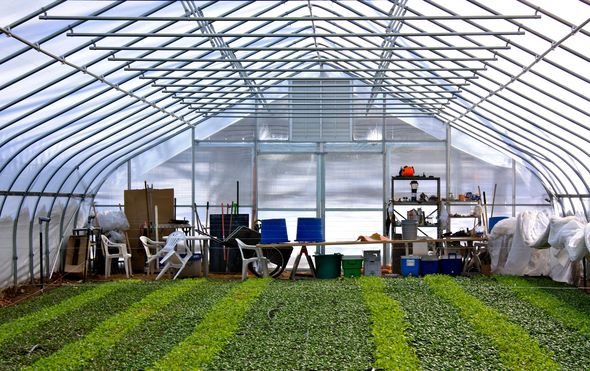
Greens growing at Brines Farm hoophouse in Dexter
Contributor | Kim Bayer
It's mid-February and the snow is piled up in drifts outside, but a carpet of green covers the floor of the hoophouse where Shannon Brines is giving a tour. When someone asks "So how did you get started with this?" Brines says "I got tired of reading about everything happening in other places, and decided I could do it here." He put up his first hoophouse, a type of passive solar greenhouse, in 2005, and currently has four in production growing food all year, with a special focus on wintertime crops.
Hoophouses, sometimes called "high tunnels" are usually steel-frame structures that use positioning, the sun's rays, and a cover made of high-tech plastic film to create an environment for cold season crops to thrive, even in bitter weather. Farmers use an additional cover, like a blanket made of plastic or other insulating material, suspended over the plants for extended cold and cloudy weather conditions.
Brines Farm was the fourth stop on a five-stop "Four Season Farming" tour in Washtenaw and Lenawee Counties put together by Jane Bush and Michaelle Rehmann of the Food System Economic Partnership (FSEP). Designed to inspire farmers and food service professionals with on the ground proof of new opportunities, the tour also demonstrated that food grown in deep winter can provide eaters with some of the tastiest and healthiest produce when they need it most and give farmers an income during a difficult time of year.
Jane Bush, FSEP Business Development Specialist, says her goal in developing the tour for farmers and food service professionals was to demonstrate "in a visual way what can be grown in the dead of winter. We want to impress upon participants what can be done in Michigan, even with very limited resources. I hope that this is an opportunity for people to form relationships, and for people individually to take action." Bush has herself put the opportunity into action by helping to start the "4 Season Produce Co-op," a federation of small farmers working together to provide fresh, locally grown greens to Allegiance Health, a regional hospital and health system located in Jackson, Mich.
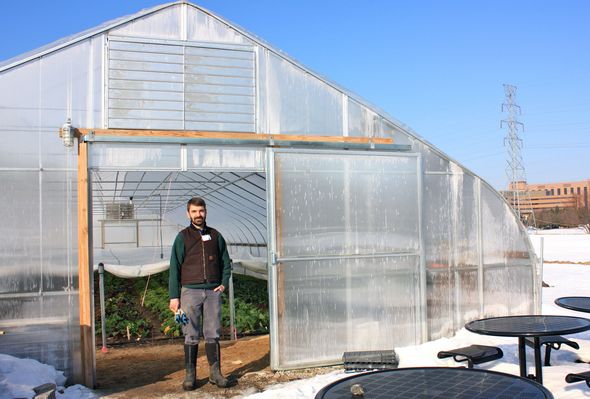
Dan Bair at the Farm at St. Joe.
Contributor | Kim Bayer
The Farm at St. Joe
Along with schools, health systems are among the institutional buyers that have shown the most interest in using locally grown produce, both to support their staff and patients' health and as a differentiator in the marketplace. With two hoophouses in production (out of 12 planned) The Farm at St. Joe is an example of a hospital system taking the leap to make the connection between food and health. Hired as a full-time employee, farmer Dan Bair has spinach, chard, collards and kale — all cold season crops — growing inside unheated steel framed structures with pointed "gothic" style roofs. On a sunny day, the temperature can easily rise above 80 degrees. Bair notes that he likes to keep the environment closer to 60 degrees as he points out the various styles of openings in the endwalls installed to test out whether a roll-up, sliding, or regular swing door provides the most useful functionality — and cooling.
The people on the tour want to know what Bair charges for the produce at the weekly hospital farmers' market that he supplies. He says he's currently charging $9 a pound for spinach, partly because earlier in the winter people were grumbling about paying $12 a pound. He says he's heard of big city markets where greens like his go for as much as $40 a pound in the high demand winter season, and that with all the labor involved they're definitely worth $12.
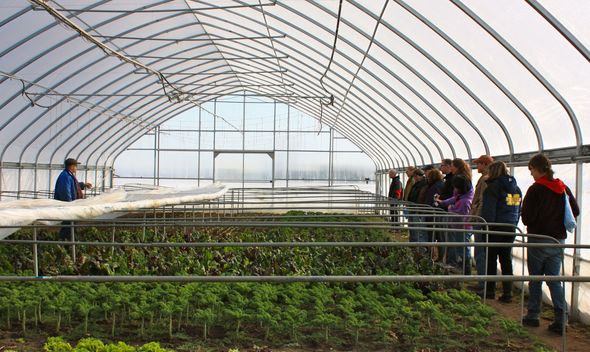
Goetz Farm hoophouse tour
Contributor | Kim Bayer
Goetz Farm
Of the farmers and the food service professionals on the tour, both groups are interested in the economics of hoophouse production even if for different reasons. Growing wintertime kale, beets, lettuce and carrots at their centennial farm in Riga, Mich., Jonathan and Karlene Goetz provide a good example of the economics that make hoophouse growing viable. They sell their winter produce at the Ann Arbor Farmers' Market but also to larger customers like Ford Motor Co. and to catering companies, and Jon Goetz says people are calling all the time. He says that their sales over eight months brought back the $11,000 purchase price of their most recent hoophouse. When someone asks if that price included the cost of labor for putting it up, Karlene Goetz adds that when you have four sons on a farm, the labor is free. Apparently it helps that they planned ahead to have those four sons.
Planning ahead is especially important for the development of farm to institution relationships. Head Chef at the East Quad dorm on the University of Michigan campus, Buzz Cummings, has been working with Goetz Farm for a couple of years already. He says he likes "the diversity of products, and they have good pricing and great service." As an institutional purchaser, Cummings is required to work with vendors committed to GAP (for Good Agricultural Practices) certification. Meeting the GAP criteria is supposed to make food safer for consumption, but Jon Goetz notes that GAP and organic certification are in conflict — and you can't do both. "GAP wants you to chlorine everything (to kill germs on the produce), but organic says don't" (because chlorine is not an approved organic input).
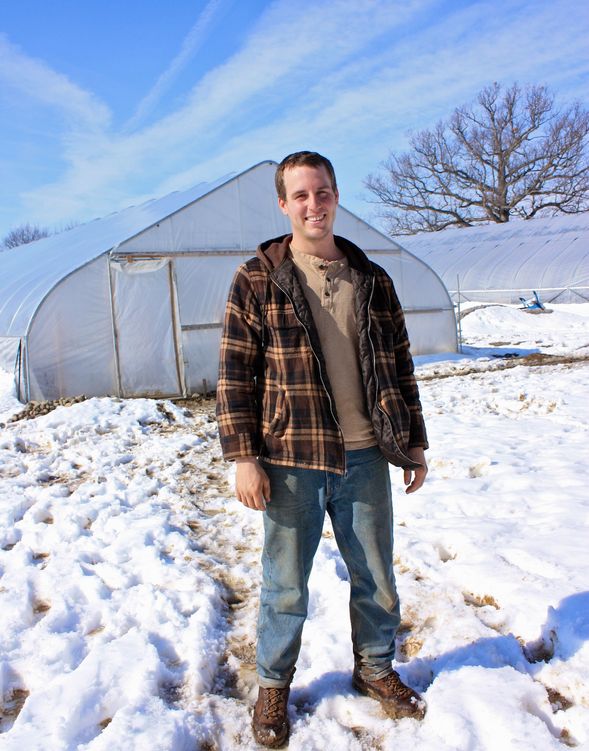
Tomm Becker at Sunseed Farm.
Contributor | Kim Bayer
Sunseed Farm
Although not "certified" organic, Tomm and Trilby Becker practice organic agriculture on the 18 acre Sunseed Farm they started last year as the area's first year-round CSA. Tomm Becker was already an experienced hoophouse farmer after several years managing what is likely the first year-round CSA in the state at the Michigan State University student organic farm. When the Beckers moved to Ann Arbor last year, they leased the farm, got married and put up two hoops with the support of Friday Mornings @SELMA, a local food breakfast salon organized to raise money for low-interest loans and volunteer labor to help farmers extend their growing season for food production. Becker says winter farming is priority for them both in terms of having an income but also because they believe it's important to supply food for the community throughout the year.
For their winter CSA members, Tomm Becker grows food in two hoophouses from January through April. He says he could potentially make more money selling to restaurants or at the market but "the CSA is our priority; I love having a relationship with the people who eat our food." The love is reflected back to him as tour participants Tom and Edith Huber exclaim, "Your vegetables are just incredible!" Green kale, purple kale, beets, chard, collards, white Hakurei turnips, carrots and spinach glow when the sun comes out and lights up the two hoops surrounded by snow. We tramp back to the bus, and, as Becker shakes hands with the people boarding, he says, "I hope I get to compete with some of you soon. We need a lot more food growing in our area."
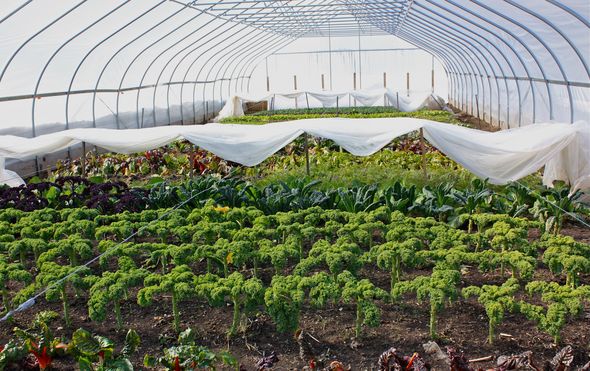
Sunseed Farm hoophouse vegetables in February
Contributor | Kim Bayer
Brines Farm
As we arrive at Brines Farm, a small herd of deer bounds off through the snow at our approach to the four hoophouses in production in the midst of towering pine trees. It's a little hoophouse district on what Shannon Brines says covers less than an acre. Here is where he grows the food for 40 winter CSA shares that last for 26 weeks from November through May. Every week members get anywhere from three to seven pounds of baby lettuce, kale, komatsuna, collards, squash, spinach, onions, potatoes, sweet potatoes, turnips and baby carrots. Brines notes that there is much more demand right now than there is locally grown food available in the winter.
His latest focus is on growing crops throughout the summer and fall months that can be dried (like hot peppers) or root cellared. In the fall, he cures his potatoes and sweet potatoes for a week in a heated space, then stores them in a crawl space at about 50-60 degrees. He still has sweet potatoes in February that have lasted five months out of the ground.
In the discussion about what kind of return he gets on the hoophouse structures (he says $8-$12,000 per house is a reasonable expectation), someone asks whether he heats any of the hoophouses. It's a reasonable question, but it also defines what's different about a hoophouse. Brines says, "It has to be low input to make sense financially." He believes the only way it works economically is if there are no electrical (aka petroleum-based) inputs.
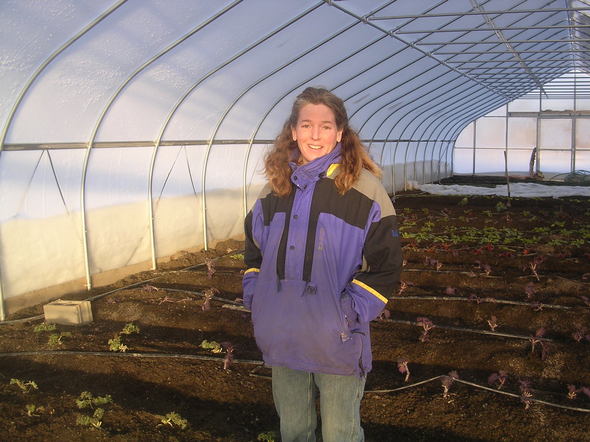
Jennifer Kangas at Capella Farm.
Photo from Jennifer Kangas
Capella Farm
Jennifer Kangas left a career in banking to start the Capella Farm CSA in 2009. In 2010 she was also a recipient of one of the hoophouses built through the funding and volunteer support of Friday Mornings @SELMA. With the new hoophouse, she has been able to expand her production, now offering a 10-week spring CSA membership March through May, and an additional fall "extension" for three weeks in October plus a large holiday share in addition to the regular 20-week summer CSA. The new spring CSA filled almost immediately with previous summer members.
Planted last fall before the ground froze, the hoophouses have small plants that are just waiting for some sunny days to grow. There's enough to do on the farm that Kangas hired a helper who has been coming two days per week throughout the winter. In the summer, Kangas says she going to need to hire three full-time helpers and two part time as she works to increase her CSA membership up to 100. She says she came on the tour "because I wanted to see what other people are doing. It's always good to share information."
The future of hoophouses in Michigan
Four season farming is a concept that provides eaters with some of the tastiest and healthiest food just when they need it most, and it gives farmers an income during a difficult time of year. If we want to become less dependent on the petroleum required for food shipped from faraway lands, then we also need to learn how to feed ourselves during the coldest months. Not only is it an opportunity for an income stream, it's also a sustainable growing method, and one that increases community resilience and employment.
Julie Harsh, Saline Schools Food Service Director, is a potential customer. She's looking for any nearby farms that can help supply produce for the kids' lunches. With the new Child Nutrition Act Re-authorization she says that she needs to put a different colored vegetable on the kids' plates every week, and children in kindergarten through eighth grade have an all-you-can-eat salad bar every single day. She doesn't serve iceberg lettuce anymore, saying, "There's no nutrition in it." She's looking for broccoli, carrots, cucumbers, spinach and romaine lettuce. She wants the Saline schools Ag Department to put up a hoophouse, and she's got the funding for it. But so far, she hasn't found anyone to take her up on it.
Wade Pregitzer, owner of Pregitzer Farm Market and CSA in Munith was impressed with what he saw on the tour. He says he has a greenhouse fund that he keeps until he has enough every couple of years to build a new one. He's anticipating that one of the next ones is going to be a hoophouse.
Kim Bayer is a freelance writer and culinary researcher.


Comments
Patricia Ward
Fri, Aug 12, 2011 : 3:33 a.m.
I am so encouraged to see these hoop houses. I live in a small city in Canada, and it's a big dream of mine to be able to buy fresh produce year round. Thanks for sharing.
Dixborodad
Thu, Jun 9, 2011 : 1:04 p.m.
Inspiring. I want a hoop house! However, there was one comment that was a bit strange.... "He believes the only way it works economically is if there are no electrical (aka petroleum-based) inputs." What was the need to call out petroleum-based? (not that I'm pro-petroleum by any means) What do you think the entire plastic coverings are made from for those hoop house structures? Petroleum based plastics. Perhaps "energy" could be used, and point out that it relies solely on passive heat, captured by the sun's rays during the day, and heat that is retained by the ground below at night. =) Cheers and happy growing.
lisa gottlieb
Tue, Feb 22, 2011 : 3:54 a.m.
Beautiful article with lovely photographs! Thanks Kim.
Corinna Borden
Fri, Feb 18, 2011 : 6:32 p.m.
Thank you Kim for this great summary of what is happening in our area. What a wonderful tour. We love our CSA greens from Brines and the Sunseed vegetables this morning at Selmas looking unreal!